The 14 Sacred Ratnas from the Churning of the Ocean (Samudra Manthan)
Ankit Gupta | Apr 30, 2025, 11:41 IST
Samudra Manthan
The churning of the ocean (Samudra Manthan) is one of the most iconic and symbolic episodes in Hindu mythology. It involved both the Devas (gods) and Asuras (demons) churning the Kshir Sagar (Ocean of Milk) to obtain Amrit (nectar of immortality). From this cosmic event, 14 divine treasures (Ratnas) emerged.
“When the ocean was churned by gods and demons alike, the universe revealed its most powerful secrets.”
One of the most fascinating episodes in Hindu mythology is the Samudra Manthan, the churning of the cosmic Ocean of Milk. It represents a profound allegory of spiritual transformation—where effort, patience, and divine intervention lead to the emergence of supreme wisdom and power.
In their quest for Amrit, the nectar of immortality, the Devas (gods) and Asuras (demons) used Mount Mandara as the churning rod and Vasuki, the serpent king, as the churning rope. As the churning intensified, the ocean yielded 14 divine treasures, each symbolizing different aspects of cosmic truth, balance, and divine order.
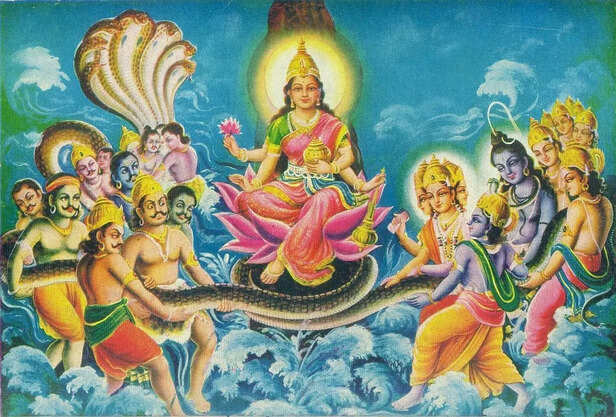
Lakshmi is the goddess of wealth, prosperity and fortune. She is one of the three supreme goddesses, with Saraswati and Parvati. She emerged from the cosmic ocean draped in her red and gold saree while seated on a grand lotus with smaller lotuses in her hands. After a long time of separation, the goddess was finally reunited with her consort, Lord Vishnu. Her return brought back the riches of the devas, giving Devaloka its earlier splendour.
The arrival of Lakshmi was followed by her counterpart and elder sister, Alakshmi, who had unkempt hair and was draped in a single white cloth. She is the goddess of misfortune, poverty and misery and is said to visit houses filled with ego, pride, selfishness, and envy. Unlike her sister Lakshmi, who likes sweet food, Alakshmi has an appetite for hot, sour and pungent food. So, many Hindu households often hang lemon and chillies at their doorstep to satisfy the appetite of the goddess of misfortune.
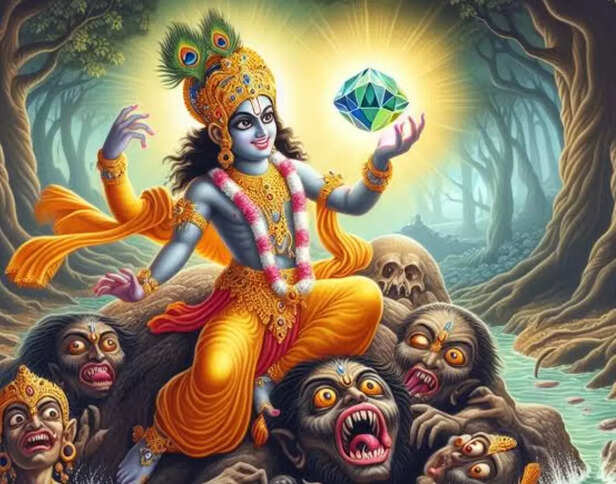
The Kaustubh Mani is the most radiant jewel ever known, which Lord Vishnu wore on his chest. It symbolizes the purest truth and clarity of consciousness, a light that guides the soul on its dharmic path. The gemstone is said to be as beautiful as an exotic lotus and as radiant as the sun.
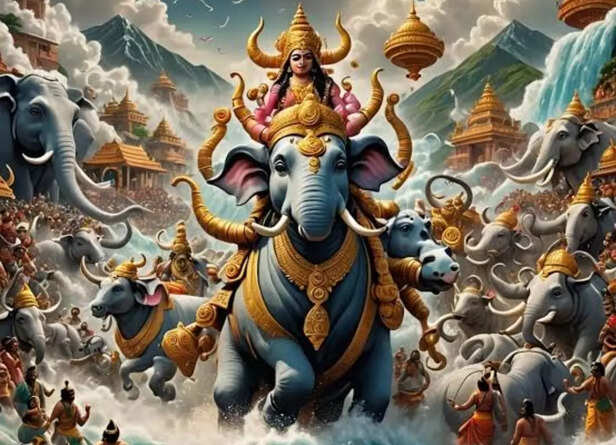
A magnificent white elephant with multiple heads, Airavata became the mount of Indra, king of the gods. As a symbol of royalty, strength, and rain, Airavata represents both protection and fertility. Airavata, the king of elephants, was a white coloured winged being with six trunks and six pairs of tusks. He said to dig his trunk deep into the ground and reach water which is inaccessible to humans. He uses his trunk to spray the water in the form of monsoon showers. After appearing from the cosmic ocean, Airavata chose to serve his master Indra, who was delighted to reunite with his loyal vahana.
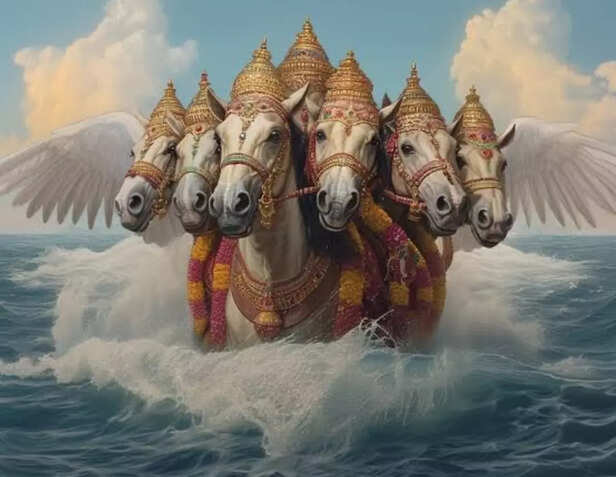
The high-pitched, snow-white celestial horse with seven heads, Uchhaishravas, was claimed by the Asuras in some versions. It signifies the swift power of the mind and the elegance of divine motion. Often considered as the king of the horses, the seven-headed, snow-white horse, was one of the three animals that appeared during the Samudra Manthan. The magnificent steed was taken by Indra. Eventually, Uchhaisravas came into the hands of King Mahabali, the asura king, who ruled over the three worlds.
Once Goddess Lakshmi was spellbound by the beauty of Uchhaisravas and forgot to pay attention to her consort, Vishnu. This infuriated him and he cursed Lakshmi to be born as a mare.
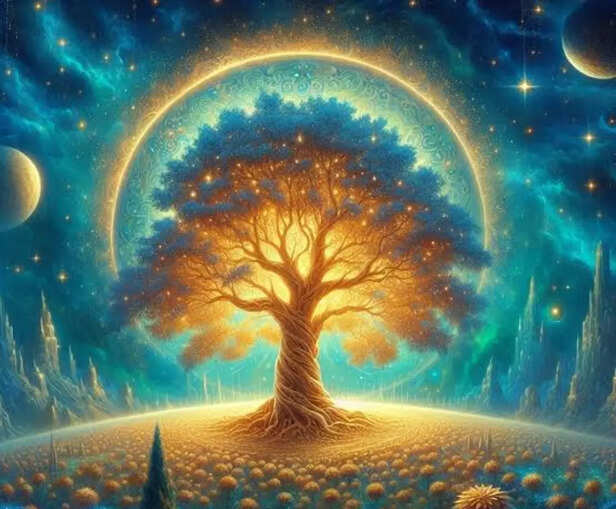
This mythological tree can grant any wish and is often associated with abundance and spiritual growth. It was planted in Indraloka, the celestial kingdom, and represents divine generosity.
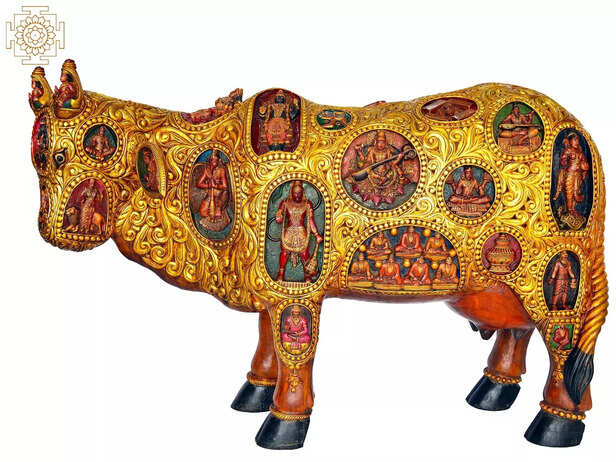
Kamdhenu was one of the precious ratnas obtained from the cosmic ocean and is considered to be the mother of all cattle. Kamdhenu is depicted with the face of a woman, the body of a cow with a pair of wings and the tail of a peacock. She was given to the Saptrishis as she provided them with ample milk. The milk was used to prepare curd and ghee which were regularly required for their sacred rituals. According to the Mahabharata, Kamdhenu was in the possession of one of the Saptrishis, Jamadagni. The sage invited King Kartavirya Arjuna to a feast. The greedy king learnt about the resourcefulness of Kamdhenu and forcefully took Kamdhenu and her calf away from the sage. The sage’s son, Parshurama, the sixth avatar or incarnation of Vishnu, single-handedly defeated the king and his army, successfully retrieving the sacred cow and her calf.
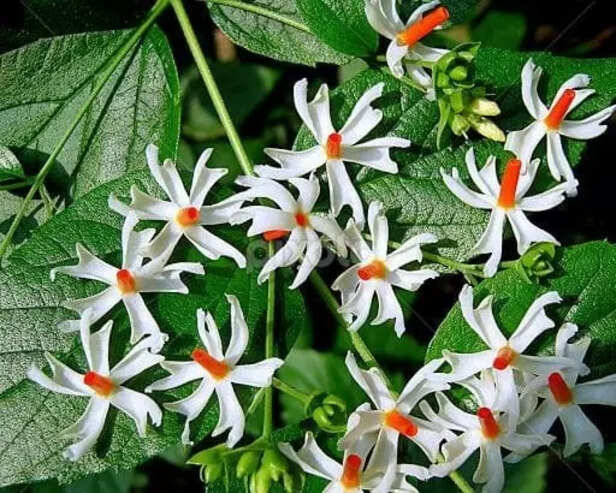
A divine tree bearing fragrant night-blooming flowers, Parijat was taken to the heavenly realms. Its flowers never wilt, representing eternal beauty and purity. It is often associated with love and devotion. From the depths of the ocean, sprung a divine flowering tree called the Parijat. The flowers of the tree were white, with a tinge of orange at the stalk. Indra decided to keep the beautiful flowering tree with the enchanting fragrance for himself and planted the tree in his garden in Devaloka. Yugas later, Krishna and Indra duelled over the tree as Krishna wanted to bring the tree bearing the scented flowers to Prithvilok for his wives Satyabhama and Rukmini. Eventually, Krishna defeated Indra, and took the tree. The tree has a special significance in Hinduism, as it is forbidden to pluck its flowers and only the fallen flowers can be used to worship deities.
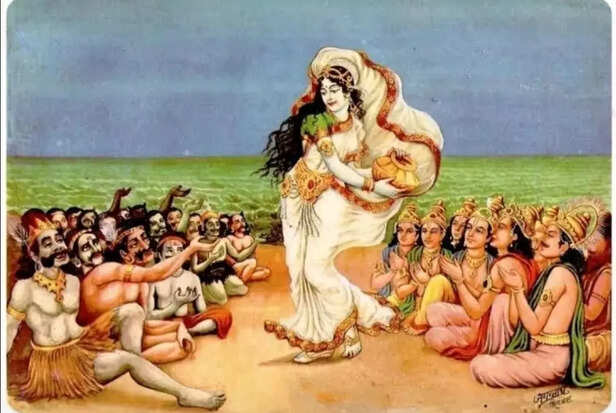
Also known as Sura, Varuni symbolizes the pleasure principle, worldly temptations, and also the intoxicating nature of divine ecstasy. She is often said to have been accepted by the Asuras, hinting at the attraction of pleasure over wisdom.
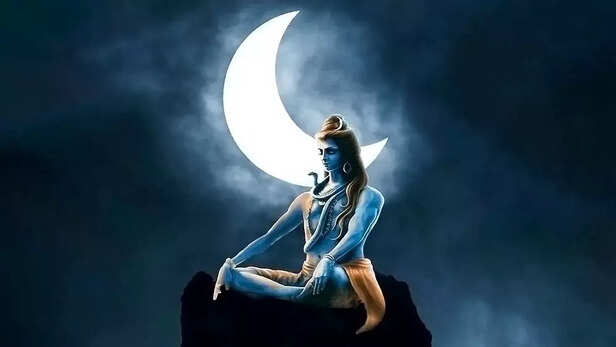
The moon God Chandra appeared as one of the precious ratnas and took refuge in the matted hair of Shiva. His father-in-law, Prajapati Daksha once cursed him for not being a good husband to his daughters. Due to the curse, Chandra lost his powers and his body started withering. After extensive prayers, Shiva came to the deity’s rescue and wore him as an ornament in his hair to neutralize the curse. However, Chandra still waxes and wanes as a result of that curse.
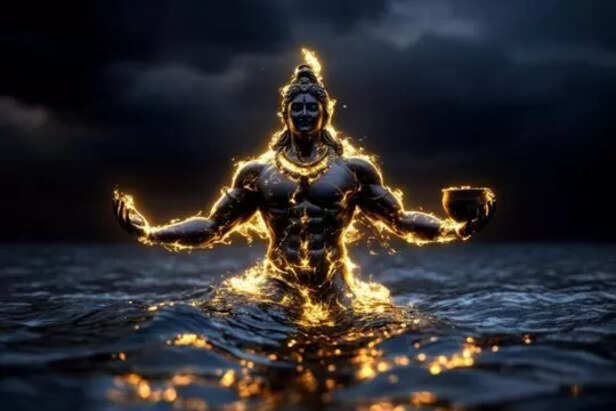
From the depths rose Dhanvantari, the first celestial doctor, carrying a pot of Amrit. He is the founder of Ayurveda, and represents healing, longevity, and wisdom of health. Dhanvantri, the physician of the gods, appeared from the turbulent ocean carrying the pot of Amrita. Dhanvantri was responsible for teaching the ancient knowledge of medical science, Ayurveda, to mortals. Brahma created Ayurveda, before he created mankind, but the vast knowledge of medical science was difficult for mortals to understand. So, Dhanvantri split the original text into eight divisions and taught his disciples
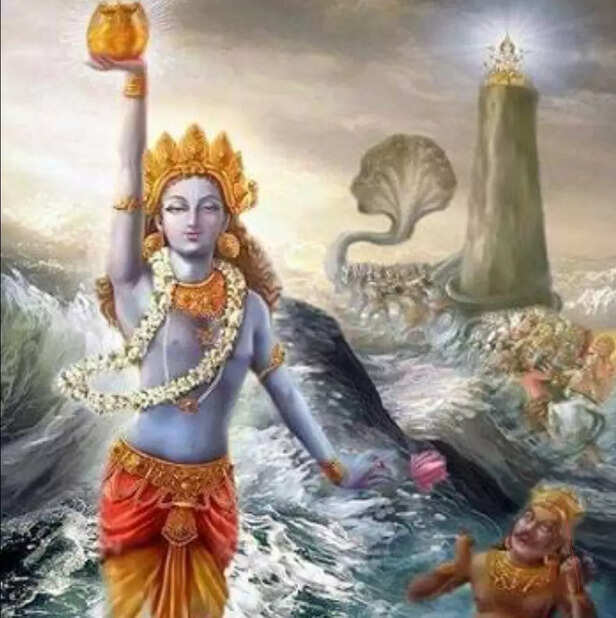
The goal of the churning was the Amrit, the divine nectar that grants immortality. It symbolizes the ultimate realization of the self, the escape from death, and the attainment of Moksha (liberation). As soon as Dhanvantri appeared with the pot of Amrit, the Asuras snatched the pot and planned to consume the entire pot of elixir. Vishnu devised a plan and took the form of an enchanting woman, Mohini. Mohini used her charm to lure the asuras out of hiding and used the opportunity to take the pot back to the Devas. While the devas were consuming the elixir to regain their divine strength back, one of the asuras, Rahuketu disguised himself as a deva to taste the Amrit. However, he was discovered just as he was pouring the liquid into his mouth. Vishnu instantly hurled the Sudarshan Chakra and beheaded Rahuketu but the amrita had already reached the asura’s throat. Rahuketu’s head and body were flung on opposite sides of the universe and became Rahu and Ketu.

The Halahala was a deadly poison that had the potential to destroy all beings in the three realms. None amongst the armies of asuras and devas stepped in to stop the poison from spreading into the universe as they feared the poison would destroy them too. Lord Shiva descended from Mount Kailash to consume the poison. Goddess Parvati, Shiva’s consort, used her powers to stop the Halahal in Shiva’s throat, and as a result, his throat turned blue. Thus he came to be called Neelkanth.
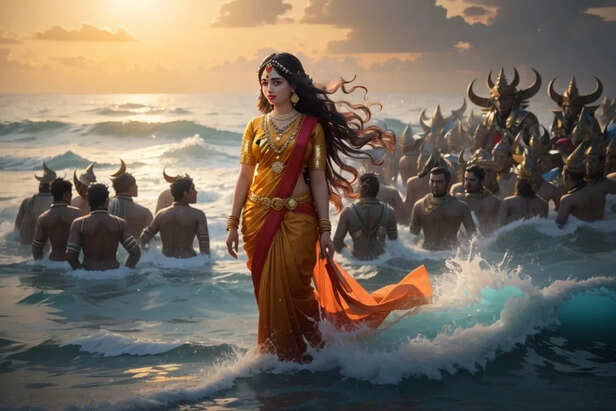
Graceful and enchanting, the Apsaras, led by Rambha, emerged to bring art, music, and pleasure into the world. They symbolize aesthetic perfection, joy, and the ephemeral nature of beauty. Apsaras are female heavenly spirits of Devaloka or the home of the gods. They are associated with music and dance. After appearing from the cosmic ocean, they chose Gandharvas as their companions. The Gandharvas served as musicians in Indra’s court. Indra, who was constantly insecure about his throne, often commanded the enchanting apsaras to distract sages or asuras from their tapasya to achieve his own ends.

Though not listed in every version, Panchajanya, the divine conch, is often associated with the Manthan. It later became Vishnu’s celestial shankha, symbolizing the sound of Dharma, and is still blown during rituals to purify the atmosphere and awaken divine energy. In ancient times the sound of the conch signified the beginning of a war. Vishnu’s conch, Panchajanya is a symbolic way of portraying his role as the preserver of the universe. God steps into battlefields again and again, in different avatars to save humanity.
Each of these 14 treasures holds deep philosophical symbolism. The story teaches us that the journey toward enlightenment and immortality involves:
One of the most fascinating episodes in Hindu mythology is the Samudra Manthan, the churning of the cosmic Ocean of Milk. It represents a profound allegory of spiritual transformation—where effort, patience, and divine intervention lead to the emergence of supreme wisdom and power.
In their quest for Amrit, the nectar of immortality, the Devas (gods) and Asuras (demons) used Mount Mandara as the churning rod and Vasuki, the serpent king, as the churning rope. As the churning intensified, the ocean yielded 14 divine treasures, each symbolizing different aspects of cosmic truth, balance, and divine order.
1. Lakshmi

Goddess of Wealth and Fortune (Image Credit: Freepik)
Lakshmi is the goddess of wealth, prosperity and fortune. She is one of the three supreme goddesses, with Saraswati and Parvati. She emerged from the cosmic ocean draped in her red and gold saree while seated on a grand lotus with smaller lotuses in her hands. After a long time of separation, the goddess was finally reunited with her consort, Lord Vishnu. Her return brought back the riches of the devas, giving Devaloka its earlier splendour.
The arrival of Lakshmi was followed by her counterpart and elder sister, Alakshmi, who had unkempt hair and was draped in a single white cloth. She is the goddess of misfortune, poverty and misery and is said to visit houses filled with ego, pride, selfishness, and envy. Unlike her sister Lakshmi, who likes sweet food, Alakshmi has an appetite for hot, sour and pungent food. So, many Hindu households often hang lemon and chillies at their doorstep to satisfy the appetite of the goddess of misfortune.
2. Kaustubh Mani

The Divine Gem
The Kaustubh Mani is the most radiant jewel ever known, which Lord Vishnu wore on his chest. It symbolizes the purest truth and clarity of consciousness, a light that guides the soul on its dharmic path. The gemstone is said to be as beautiful as an exotic lotus and as radiant as the sun.
3. Airavata

Celestial White Elephant (Image Credit: Pixel)
A magnificent white elephant with multiple heads, Airavata became the mount of Indra, king of the gods. As a symbol of royalty, strength, and rain, Airavata represents both protection and fertility. Airavata, the king of elephants, was a white coloured winged being with six trunks and six pairs of tusks. He said to dig his trunk deep into the ground and reach water which is inaccessible to humans. He uses his trunk to spray the water in the form of monsoon showers. After appearing from the cosmic ocean, Airavata chose to serve his master Indra, who was delighted to reunite with his loyal vahana.
4. Uchhaishravas

Seven-Headed Horse
The high-pitched, snow-white celestial horse with seven heads, Uchhaishravas, was claimed by the Asuras in some versions. It signifies the swift power of the mind and the elegance of divine motion. Often considered as the king of the horses, the seven-headed, snow-white horse, was one of the three animals that appeared during the Samudra Manthan. The magnificent steed was taken by Indra. Eventually, Uchhaisravas came into the hands of King Mahabali, the asura king, who ruled over the three worlds.
Once Goddess Lakshmi was spellbound by the beauty of Uchhaisravas and forgot to pay attention to her consort, Vishnu. This infuriated him and he cursed Lakshmi to be born as a mare.
5. Kalpavriksha

Wish-Fulfilling Tree (Image Credit: Freepik)
This mythological tree can grant any wish and is often associated with abundance and spiritual growth. It was planted in Indraloka, the celestial kingdom, and represents divine generosity.
6. Kamadhenu

Sacred Cow (Image Credit: pixel)
Kamdhenu was one of the precious ratnas obtained from the cosmic ocean and is considered to be the mother of all cattle. Kamdhenu is depicted with the face of a woman, the body of a cow with a pair of wings and the tail of a peacock. She was given to the Saptrishis as she provided them with ample milk. The milk was used to prepare curd and ghee which were regularly required for their sacred rituals. According to the Mahabharata, Kamdhenu was in the possession of one of the Saptrishis, Jamadagni. The sage invited King Kartavirya Arjuna to a feast. The greedy king learnt about the resourcefulness of Kamdhenu and forcefully took Kamdhenu and her calf away from the sage. The sage’s son, Parshurama, the sixth avatar or incarnation of Vishnu, single-handedly defeated the king and his army, successfully retrieving the sacred cow and her calf.
7. Parijat

Celestial Flowering Tree
A divine tree bearing fragrant night-blooming flowers, Parijat was taken to the heavenly realms. Its flowers never wilt, representing eternal beauty and purity. It is often associated with love and devotion. From the depths of the ocean, sprung a divine flowering tree called the Parijat. The flowers of the tree were white, with a tinge of orange at the stalk. Indra decided to keep the beautiful flowering tree with the enchanting fragrance for himself and planted the tree in his garden in Devaloka. Yugas later, Krishna and Indra duelled over the tree as Krishna wanted to bring the tree bearing the scented flowers to Prithvilok for his wives Satyabhama and Rukmini. Eventually, Krishna defeated Indra, and took the tree. The tree has a special significance in Hinduism, as it is forbidden to pluck its flowers and only the fallen flowers can be used to worship deities.
8. Varuni

Goddess of Wine (Image Credit: Pixabay)
Also known as Sura, Varuni symbolizes the pleasure principle, worldly temptations, and also the intoxicating nature of divine ecstasy. She is often said to have been accepted by the Asuras, hinting at the attraction of pleasure over wisdom.
9. Chandra

Shiva Adorned Moon
The moon God Chandra appeared as one of the precious ratnas and took refuge in the matted hair of Shiva. His father-in-law, Prajapati Daksha once cursed him for not being a good husband to his daughters. Due to the curse, Chandra lost his powers and his body started withering. After extensive prayers, Shiva came to the deity’s rescue and wore him as an ornament in his hair to neutralize the curse. However, Chandra still waxes and wanes as a result of that curse.
10. Dhanvantari

Divine Physician
From the depths rose Dhanvantari, the first celestial doctor, carrying a pot of Amrit. He is the founder of Ayurveda, and represents healing, longevity, and wisdom of health. Dhanvantri, the physician of the gods, appeared from the turbulent ocean carrying the pot of Amrita. Dhanvantri was responsible for teaching the ancient knowledge of medical science, Ayurveda, to mortals. Brahma created Ayurveda, before he created mankind, but the vast knowledge of medical science was difficult for mortals to understand. So, Dhanvantri split the original text into eight divisions and taught his disciples
11. Amrit

Nectar of Immortality
The goal of the churning was the Amrit, the divine nectar that grants immortality. It symbolizes the ultimate realization of the self, the escape from death, and the attainment of Moksha (liberation). As soon as Dhanvantri appeared with the pot of Amrit, the Asuras snatched the pot and planned to consume the entire pot of elixir. Vishnu devised a plan and took the form of an enchanting woman, Mohini. Mohini used her charm to lure the asuras out of hiding and used the opportunity to take the pot back to the Devas. While the devas were consuming the elixir to regain their divine strength back, one of the asuras, Rahuketu disguised himself as a deva to taste the Amrit. However, he was discovered just as he was pouring the liquid into his mouth. Vishnu instantly hurled the Sudarshan Chakra and beheaded Rahuketu but the amrita had already reached the asura’s throat. Rahuketu’s head and body were flung on opposite sides of the universe and became Rahu and Ketu.
12. Halahala – The Deadly Poison

Image Credit: freepik
The Halahala was a deadly poison that had the potential to destroy all beings in the three realms. None amongst the armies of asuras and devas stepped in to stop the poison from spreading into the universe as they feared the poison would destroy them too. Lord Shiva descended from Mount Kailash to consume the poison. Goddess Parvati, Shiva’s consort, used her powers to stop the Halahal in Shiva’s throat, and as a result, his throat turned blue. Thus he came to be called Neelkanth.
13. Apsaras

Celestial Nymph
Graceful and enchanting, the Apsaras, led by Rambha, emerged to bring art, music, and pleasure into the world. They symbolize aesthetic perfection, joy, and the ephemeral nature of beauty. Apsaras are female heavenly spirits of Devaloka or the home of the gods. They are associated with music and dance. After appearing from the cosmic ocean, they chose Gandharvas as their companions. The Gandharvas served as musicians in Indra’s court. Indra, who was constantly insecure about his throne, often commanded the enchanting apsaras to distract sages or asuras from their tapasya to achieve his own ends.
14. Panchajanya

Conch of Vishnu
Though not listed in every version, Panchajanya, the divine conch, is often associated with the Manthan. It later became Vishnu’s celestial shankha, symbolizing the sound of Dharma, and is still blown during rituals to purify the atmosphere and awaken divine energy. In ancient times the sound of the conch signified the beginning of a war. Vishnu’s conch, Panchajanya is a symbolic way of portraying his role as the preserver of the universe. God steps into battlefields again and again, in different avatars to save humanity.
The Hidden Message of Samudra Manthan
- The emergence of both poison and nectar—we must face suffering before attaining bliss.
- The need for balance—Devas and Asuras worked together, symbolizing the harmony of opposing forces.
- The significance of sacrifice and grace—Lord Shiva’s selflessness and Vishnu’s guidance ensured the cosmos remained in order.
